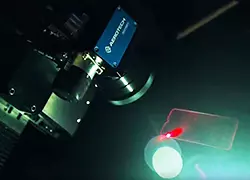What Is a Laser Scan Head? | Functions, Galvo Systems & Use Cases
What is a laser scan head? A laser scan head is a sophisticated device that steers a laser beam with incredible speed and precision. In any advanced...
Work with our team to determine which products or systems are the best fit for your application.
Some Aerotech products are available for immediate order in North America through our partner Motion Plus.

A case study examining display production that optimizes quality and throughput – and lower total cost.
3 min read
 Bryan Germann
Jun 30, 2025 2:26:51 PM
Bryan Germann
Jun 30, 2025 2:26:51 PM
Laser cutting has become a cornerstone of modern manufacturing for a clear reason: it offers a powerful combination of precision, speed and versatility that traditional cutting methods often cannot match. The core advantages of laser cutting stem from its use of a focused beam of light as a non-contact "tool," which leads to cleaner cuts, less material waste and greater design freedom.
The core advantages of laser cutting stem from its use of a focused beam of light as a non-contact "tool," which leads to cleaner cuts, less material waste and greater design freedom.
From fabricating intricate medical devices to profiling large industrial components, laser cutting provides a superior solution for a vast range of materials and applications. This article explores the key benefits that make this precision laser material processing technology an indispensable part of today's advanced manufacturing landscape.
Before diving into the benefits, it's helpful to answer the question, “what is laser cutting?” The process uses a high-power laser beam, directed and focused by optics, to sever materials. A typical laser cutting machine generates a beam that is precisely guided to the workpiece. When the focused energy strikes the material, it is rapidly heated to its melting or vaporization point.
Simultaneously, a jet of assist gas, such as oxygen or nitrogen, is directed into the cut zone. This gas clears away the molten and vaporized material, creating a narrow channel known as a "kerf." The entire operation is driven by a computer numerical control (CNC) system that moves the laser head or the workpiece along a programmed path to create the desired shape with exceptional accuracy.
Lasers cut through materials by delivering an intense concentration of energy to a microscopic spot. This focused energy is absorbed by the material, causing a near-instantaneous phase change from solid to liquid and gas. This localized melting and vaporization is the primary cutting mechanism.
The effectiveness of the cut depends on several key laser cutting conditions that must be carefully controlled and synchronized:
Laser Power and Mode: The laser must have sufficient power to melt or vaporize the material, and a high-quality beam mode allows for a smaller, more intense focused spot.
Traverse Speed: The speed at which the beam moves across the material must be balanced with the power to ensure a full-penetration cut without causing excessive heat damage.
Assist Gas: The type and pressure of the assist gas are critical for cleanly ejecting material from the kerf and, in some cases, adding chemical energy to the process (as with oxygen cutting steel).
While a full discussion of laser cutting advantages and disadvantages would show it is not the perfect tool for every single job, one major advantage of laser beam cutting stands out: its high precision combined with design flexibility.
Because the laser beam can be focused to a spot mere micrometers in diameter, it can create extremely fine details, sharp corners and intricate patterns that are impossible to achieve with mechanical cutting tools. This capability allows engineers and designers to create parts with a level of complexity previously unimaginable. Furthermore, since the process is software-driven, a design can be changed instantly by loading a new digital file, making it ideal for everything from rapid prototyping to high-volume, customized production without the need for expensive custom tooling.
Yes, not only can you cut with a galvo laser, but it is the preferred method for many high-speed, high-precision applications. A galvo laser uses a scan head with small, fast-moving mirrors to steer the laser beam instead of moving a large gantry. This allows for extremely high acceleration and agility.
Galvo laser cutting is ideal for:
Thin and Delicate Materials: The non-contact nature and high speed are perfect for cutting flexible circuits, thin metal foils, textiles, and polymers without distortion.
Intricate Patterns: The agility of the galvo mirrors allows it to trace complex filigree patterns for medical devices like stents or decorative designs with unmatched speed.
Scribing: Galvos are used to create fine, precise scribe lines on brittle materials like glass and silicon wafers, enabling clean, controlled breaks for separating individual components.
By combining the speed of a galvo scanner with the precision motion of a servo stage, it's possible to process large parts quickly and without any stitching errors.
What is a laser scan head? A laser scan head is a sophisticated device that steers a laser beam with incredible speed and precision. In any advanced...
What is beam steering used for? Beam steering is the technology used to rapidly and precisely control the direction of a laser beam. In advanced...
What are the applications of laser cutting? Laser cutting is one of the most versatile and widely adopted technologies in modern manufacturing,...